
In 2020-2021, the Canadian Fitness and Lifestyle Research Institute (CFLRI) conducted a survey of Canadian Sport Organizations (national, provincial/territorial, and community level). Recognizing the critical role that sport organizations play in facilitating physical activity and sport participation among Canadians, this survey was developed with the purpose of collecting important information regarding the availability of facilities, policies, programs and other opportunities to participate in sport and physical activity. This summary will focus on the perceptions of sport administrators about their organizations’ respective policies and standards. More specifically, this survey asked administrators to report on the availability of documented guidelines and the influence of Canada’s national policies (e.g., Canadian Sport Policy, Common Vision, Framework for Recreation) on the organization’s own policies, programming, and operations. Increasing sport participation and physical activity levels among all Canadians will require increasing opportunities in support of physical activity and sport participation, and in particular, among key population groups that are known to demonstrate lower levels of participation. In this survey, administrators were also asked to report on steps taken by their organizations to promote equity, diversity and inclusion in sport policies and programming.
Availability of documented policies to guide procedures and practices
An important step to ensuring quality sport programming is to have documented policies/statements to guide procedures and practices. As such this survey asked administrators to report which, if any written policies are available within their organization on a variety of topics. According to administrators, roughly three-quarters or more of sport organizations in Canada have written policies or guidelines regarding return-to-play protocols to address COVID-19 (80%), abuse and harassment in sport (74%), and ensuring quality standards for coaching and officials (72%). When asked about policies that specifically address factors related to discrimination based on gender, race/culture and varying abilities/disabilities, slightly more than half of administrators indicated that these policies exist (see Figure 1).
Figure 1: Percentage of organizations indicating availability of documented policies

Source: CFLRI; 2020-2021 Sport Organization survey
Region – Availability of documented guiding policies generally did not vary by region, with a few exceptions. A greater proportion of sport organizations in Ontario reported having written guidelines on implementing injury or concussion return-to-play protocols (77%) and policies addressing discrimination based on race and culture (68%) compared to the national average (63% and 58% respectively). Organizations in Ontario were also more likely than the national average to have guidelines addressing discrimination based on gender (67% vs. 55%) or discrimination based on abilities or disabilities (65% vs. 54%), whereas organizations in Quebec were less likely than the average to report having these policies (See Figure 2).
Figure 2: Regional difference in availability of documented policies
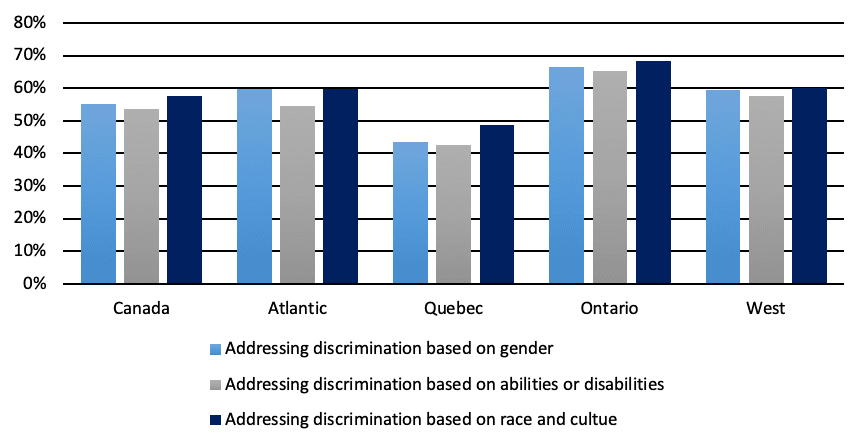
*Data for North not suppressed due to cell size
Source: CFLRI; 2020-2021 Sport Organization survey;
Organizational size – For the purposes of this report, organizations were categorized based on the number of registrants or participants that they serve (i.e., 150 or less registrants or participants and greater than 150). The results from this survey demonstrated a difference in the availability of documented policies based on organization size. Specifically, larger organizations were more likely than smaller organizations (those with less than 150 participants) to say they have the documented policies for establishing return-to-play guidelines or standards to address COVID-19 and addressing abuse and harassment in sport for all participants (See Figure 3).
Figure 3: Percentage of organizations indicating availability of documented policies by organization size
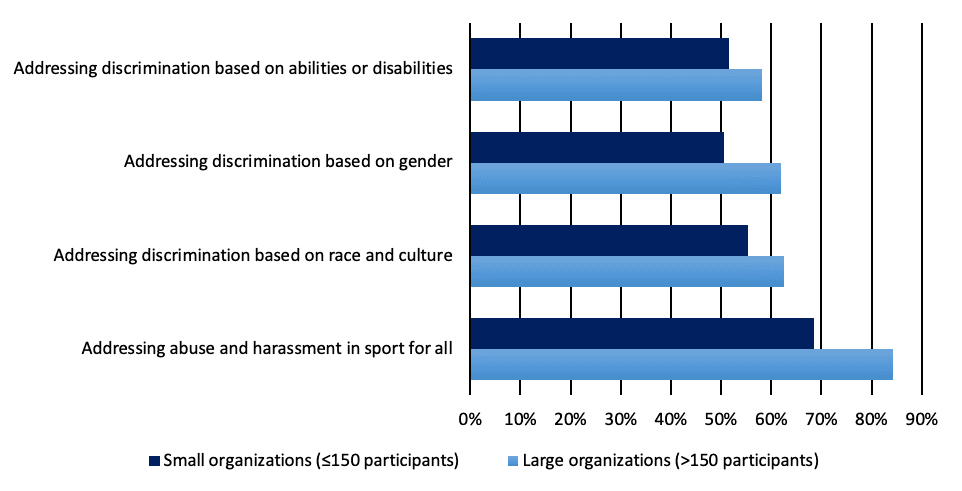
Source: CFLRI; 2020-2021 Sport Organization survey
Influence of national policies/strategies on organizational policies, programming and perceptions
In addition to understanding what policies are in place to guide organizations’ programming, the survey examined the extent to which national policies, such as the Canadian Sport Policy, influenced their own organization’s policies and programming. Table 1 describes the findings.
Table 1. Ratings of influence of national strategies on organizations’ own policies
| A great extent | Some extent | Not at all | Don’t Know/not applicable | |
| Long-term (Athlete) Development Framework | 44% | 29% | 16% | 12% |
| Canadian Guidelines on Concussion in Sport | 33% | 30% | 25% | 13% |
| Canadian Sport Policy | 25% | 42% | 18% | 16% |
| Universal Code of Conduct Preventing and Addressing Maltreatment in Sport | 24% | 28% | 28% | 21% |
| Common Vision for Increasing Physical Activity and Reducing Sedentary Living in Canada: Let’s Get Moving | 17% | 30% | 37% | 17% |
| Consensus Statement for Physical Literacy | 9% | 24% | 41% | 26% |
| Framework for Recreation in Canada | 9% | 26% | 40% | 26% |
Source: CFLRI; 2020-2021 Sport Organization survey
Administrators were also asked whether they observed a change in their organizations’ perceptions on a number of factors related to their organization’s policies and practices following the development of the CSP in 2012. Roughly half of sport organizations (47%) noted an increase in perceptions on encouraging fun in sport participation. Four out of ten organizations noted an increase in their organizations’ perceptions on ensuring a culture of ethics, respect or integrity in sport (43%), and encouraging inclusivity and accessibility (41%), whereas roughly the same proportion reported no change in their organizations’ perceptions on addressing discrimination based on race and culture or gender. Less than five percent of organizations observed a decrease in their organizations perceptions since 2012 (see Figure 4).
Figure 4: Percentage of organizations indicating change in perceptions

Source: CFLRI; 2020-2021 Sport Organization survey
Region – Compared to the national average, relatively more sport organizations in the West and relatively fewer in Quebec reported an increase in their organizations’ perceptions on addressing abuse and harassment since 2012. Sport organizations in Quebec were also less likely than the average to report an increase in their organizations’ perceptions addressing discrimination based on gender, or race and culture. Similarly, compared to the average, fewer organizations in Quebec reported an increase in their perceptions on encouraging inclusivity and accessibility (see Figures 5a & 5b). Sport administrators in Ontario were also more likely than Canadians overall to report an increase in perceptions on ensuring appropriate return-to-play protocols after a concussion or other injury.
Figure 5a: Regional differences in changes in perceptions among sport organizations
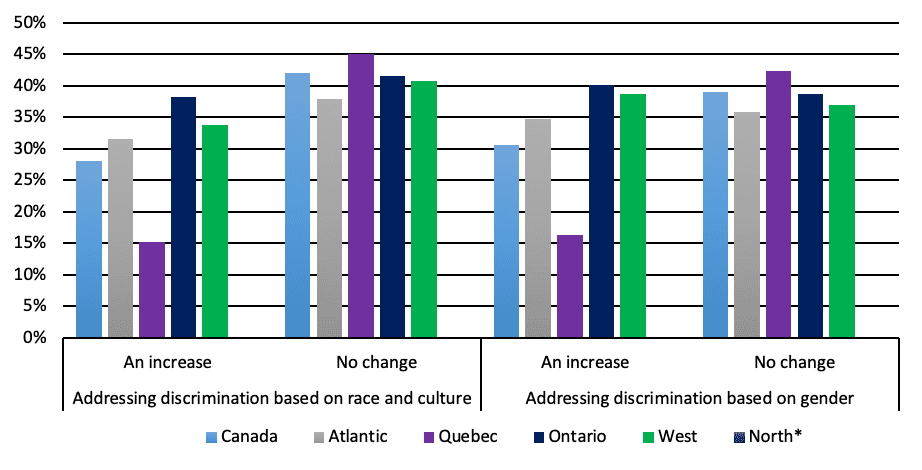
Source: CFLRI; 2020-2021 Sport Organization survey; *Data for the North suppressed due to cell size
Figure 5b: Regional differences in changes in perceptions among sport organizations
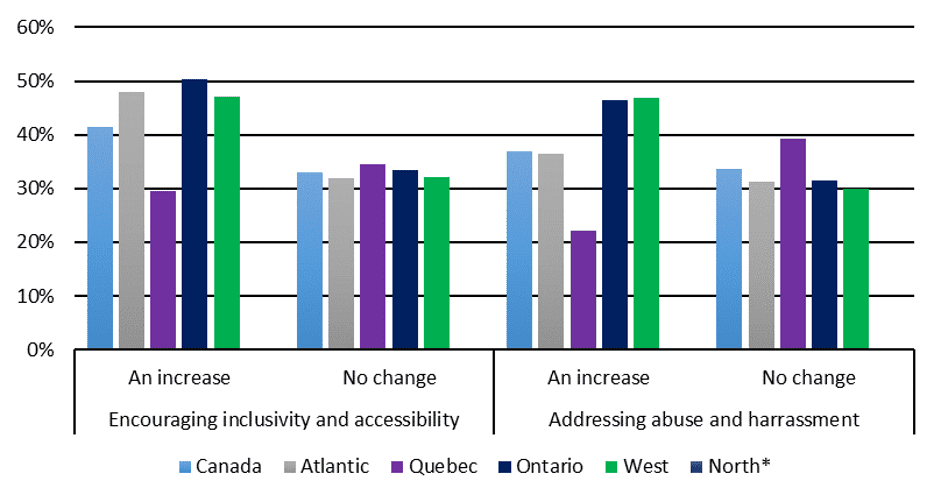
Source: CFLRI; 2020-2021 Sport Organization survey; *Data for the North suppressed due to cell size
Organization size – Differences in reported changes in perceptions from 2012 generally did not differ by organization size.
Actions taken to facilitate equity, diversity and inclusion (EDI)
The 2012 CSP outlined a set of values, which included inclusion and accessibility, to inform policies and programs with the goal of developing sport programming for all Canadians. To this end, the 2020-2021 Sport Organization survey asked sport administrators to indicate the extent to which key individuals are informed about plans, strategies, and initiatives to address gender gaps in the organization. Most organizations (89%) indicated that provincial/territorial member associations were informed regarding this to a great extent, whereas between 30-40% of senior leaders, board members, paid staff or coaches were informed about plans to address gender gaps to a great extent. Perhaps not surprising, a small proportion (16%) of participants and registrants were informed about initiatives to address gender gaps in the organization.
Administrators were asked to report on specific actions taken by the organization to make sport programming more accessible, equitable and inclusive. Close to half of organizations (49%) indicated that they provided subsidized fees for participants in need of assistance. Roughly four in ten organizations ensure that gender equity or diversity is reflected in sport programming and services and ensure gender representation among leadership and staff. To a lesser extent, organizations ensured gender-equitable funding for programs (24%), provided training to board, staff or volunteers on gender equity in sports (23%), or provided training to staff to ensure they had adequate knowledge and skills to deliver athlete development activities for persons with a disability (21%). Providing culturally relevant athlete development pathways, ensuring cultural representation among leaders and providing supports or incentives to improve access for parents (e.g., child care) were the least reported actions reported (see Figures 6a & 6b).
Figure 6a: Percentage of organizations indicating actions are taken to make programming more accessible, equitable and inclusive
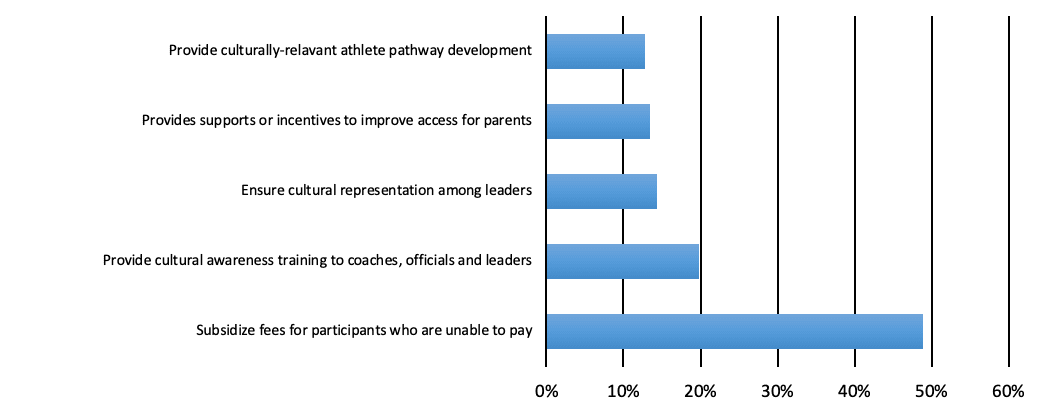
Source: CFLRI; 2020-2021 Sport Organization survey;
Figure 6b: Percentage of organizations indicating actions are taken to make programming more accessible, equitable and inclusive
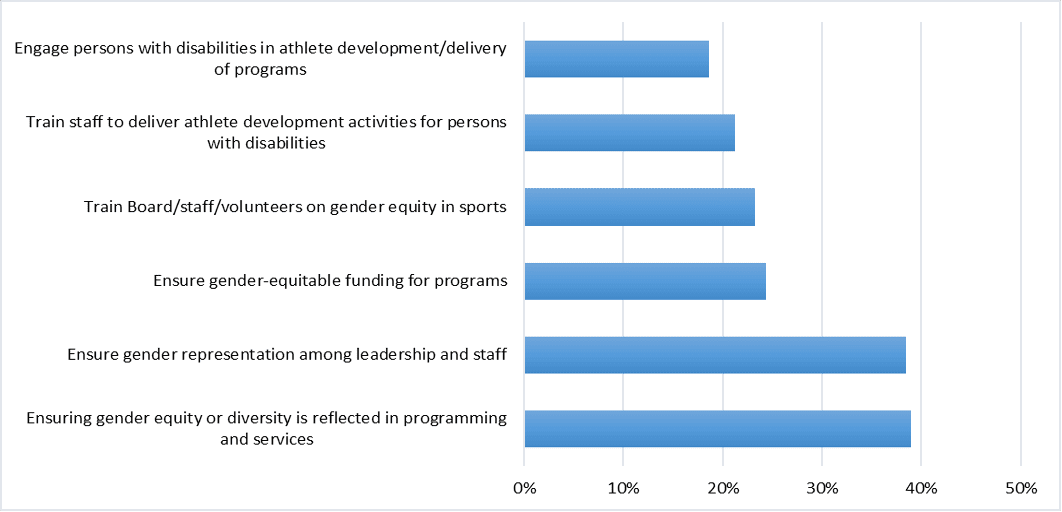
Source: CFLRI; 2020-2021 Sport Organization survey;
Region-Sport organizations in Ontario were more likely than Canadian organizations overall to say they provided training to board, staff or volunteers on gender equity (33% vs 23%), otherwise there were no other significant differences by region.
Organization size-There are generally few differences between small and large organizations when it came to efforts taken to make sport programming more accessible, equitable and inclusive. Specifically, large sport organizations (>150 participants) were more likely than small organizations (those with 150 participants or less) to agree to a great extent that senior leaders, board members and paid staff were informed about plans, strategies or initiatives to address gender gaps in the organization. Larger organizations were also more likely to say they provided training to board/staff/volunteers on gender equity in sports; ensured gender-equitable funding and gender representation among leadership and staff (see Figure 7).
Figure 7: Percentage of organizations indicating actions taken to make sport programming more accessible, equitable and inclusive by organization size
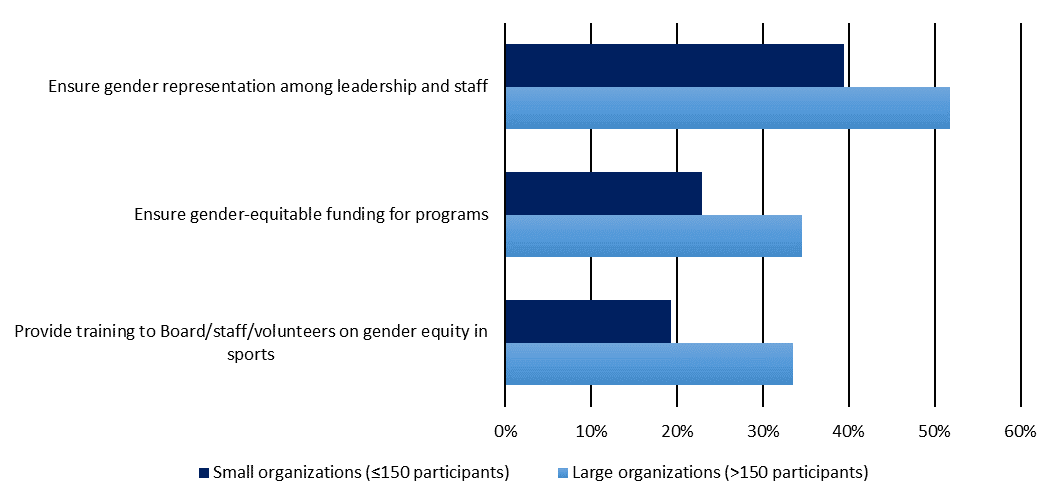
Source: CFLRI; 2020-2021 Sport Organization survey;
Production of this summary has been made possible through a financial contribution from the Government of Canada. The views expressed herein do not necessarily represent their views.


